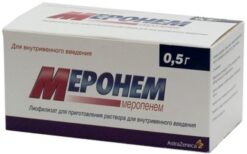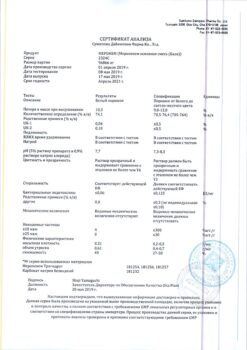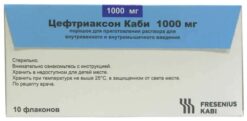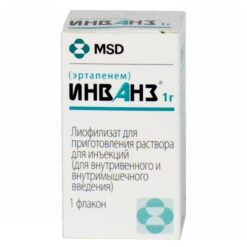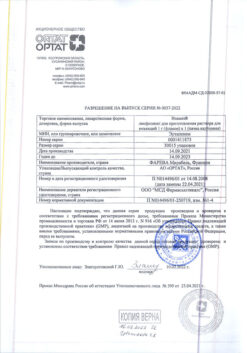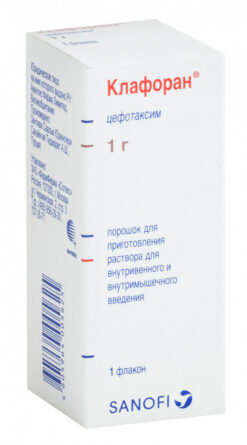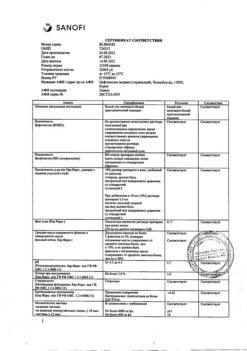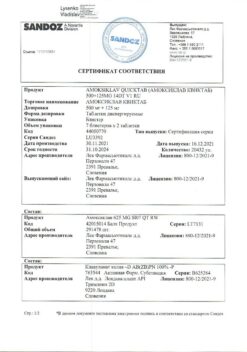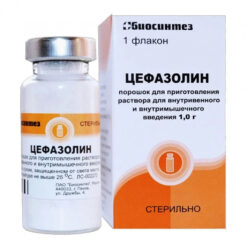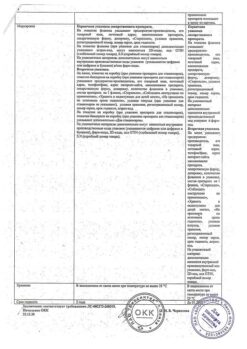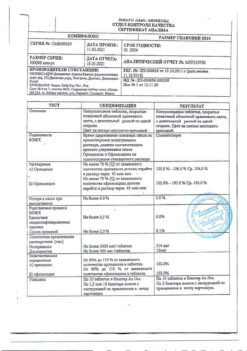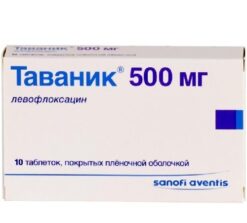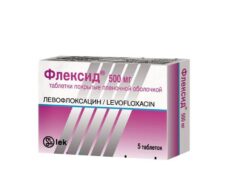No products in the cart.
Meronym, 1 g 10 pcs
€1.00
Out of stock
(E-mail when Stock is available)
Description
Pharmacology
Mechanism of action
Meropenem is a broad-spectrum carbapenem antibiotic for parenteral use, resistant to the action of beta-lactamases. The bactericidal activity of meropenem is due to inhibition of bacterial cell wall synthesis.
Meropenem rapidly penetrates the cell wall of most Gram-positive and Gram-negative bacteria and interacts with penicillin-binding proteins (PBP). It has the highest affinity to PBP 2 of Escherichia coli , PBP 2 and 3 of Pseudomonas aeruginosa and 1, 2 and 4 of Staphylococcus aureus.
Meropenem is stable in the presence of most serine beta-lactamases (penicillinase and cephalosporinase) produced by Gram-positive and Gram-negative bacteria.
Microbiology
The in vitro sensitivity of a specific isolate to meropenem must be determined by standard methods. Interpretation of in vitro test results should be made in accordance with existing recommendations for infectious diseases and clinical microbiology. Meropenem has been shown to be active against the microorganisms listed below for the clinical infections listed in the “Indications” field.
Aerobic and facultative gram-positive microorganisms: Staphylococcus aureus (only methicillin sensitive strains), Staphylococcus epidermidis (only methicillin sensitive strains), Streptococcus agalactiae, Streptococcus pneumoniae, Streptococcus pyogenes, Streptococcus viridans.
Aerobic and facultative gram-negative microorganisms: Citrobacter freundii, Enterobacter cloacae, Escherichia coli, Haemophilus influenzae (including strains producing beta-lactamase), Klebsiella oxytoca, Klebsiella pneumoniae, Morganella morganii, Neisseria meningitidis, Proteus mirabilis, Pseudomonas aeruginosa, Serratia marcescens.
Gram-positive anaerobes: Peptostreptococcus species, Clostridium perfringens.
Gram-negative anaerobes: Bacteroides fragilis, Bacteroides ovatus, Bacteroides thetaiotaomicron, Bacteroides vulgatus, Prevotella bivia.
Published literature on medical microbiology describes the in vitro sensitivity to meropenem of many other bacterial species. However, the clinical relevance of in vitro results must be confirmed by local experts in infectious diseases and clinical microbiology and appropriate clinical guidelines. The clinical safety and efficacy of meropenem have not been established for the treatment of infections caused by the following microorganisms.
Aerobic and facultative gram-positive microorganisms: Streptococcus anginosus.
Aerobic and facultative gram-negative microorganisms: Enterobacter aerogenes.
The minimum bactericidal concentration (MBC) and minimum inhibitory concentration (MIC) values were little affected by changes in inoculum concentration between 104 and 108 CFU/mL or by performing studies in pH-adjusted broth in the 5-7 range or in test medium supplemented with 50% human serum. At pH 8, only P.aeruginosa was observed to increase MPC and MBK.
Postantibiotic effects of meropenem for ≥0.5 h after antibiotic administration were obtained in 87% of all strains tested, including strains of Enterobacteriaceae, Gram-positive aerobic bacteria, B.fragilis and in vivo in mice with neutropenia infected with P.aeruginosa.
In vitro tests show that meropenem acts synergistically with aminoglycoside antibiotics against certain isolates of Pseudomonas aeruginosa and Enterobacteriaceae. Meropenem and vancomycin act synergistically against some enterococci and coagulase-positive and coagulase-negative strains of staphylococci, including those resistant to methicillin. These in vitro tests show no antagonistic effect of meropenem with aminoglycosides or vancomycin against Gram-negative and Gram-positive aerobes, respectively.
Resistance
Meropenem is active against many bacteria resistant to other antibiotics. Meropenem has been active against bacteria with known resistance mechanisms such as S.aureus, S.epidermidis, N.gonorrhoeae or M.catarrhalis that produce beta-lactamase, H.influenzae that are resistant to ampicillin or produce beta-lactamase, and S.pneumoniae that are resistant to penicillin. Meropenem has high activity against strains of Staphylococcus aureus, Enterobacteriaceae and P.aeruginosa expressing plasmid or chromosome-encoded beta-lactamases. It is unaffected when tested against Enterobacteriaceae strains containing transferable (plasmid-mediated) beta-lactamases that hydrolyze ceftazidime, cefotaxime and other third generation cephalosporins.
The sequential passaging with meropenem did not result in resistant S.aureus strains. In contrast, 10 consecutive passages with meropenem increased IPC values for each K.pneumoniae, E.cloacae or S.marcescens strain; two further studies failed to select enterobacteriaceae with increased IPC values by point mutation.
Bacterial resistance to meropenem can be caused by one or more of the following factors: reduced outer membrane permeability of Gram-negative bacteria (due to reduced porin production), reduced affinity for target PBP, increased expression of efflux pump components, and production of beta-lactamases that can hydrolyze carbapenems.
Sensitivity
If possible, the clinical microbiology laboratory should provide the physician with in vitro sensitivity test results for the antimicrobial drugs used in community health facilities in the form of periodic reports describing the sensitivity profile for nosocomial and out-of-hospital pathogens. These reports should assist the physician in selecting the most effective antimicrobial agent.
Dilution Methods. Quantitative methods are used to determine the IPC of antimicrobial drugs. The obtained MAC values allow to estimate the sensitivity of bacteria to antimicrobial drugs. MPC must be determined using a standardized procedure based on the dilution method (broth or agar) or equivalent with standardized concentrations of inoculum and standardized concentrations of meropenem powder.
Diffusion methods. Quantitative methods that require measurement of zone diameters provide reproducible estimates of the sensitivity of bacteria to antimicrobial drugs. One such standardized procedure requires the use of standardized concentrations of inoculum. This procedure uses paper disks impregnated with 10 µg of meropenem to test the sensitivity of microorganisms to meropenem.
The anaerobic methods. For anaerobic bacteria, sensitivity to meropenem, expressed as MPC values, must be determined by standardized test methods.
Pharmacokinetics
The pharmacokinetics of meropenem are typical of parenteral beta-lactam antibiotics, which bind only slightly to plasma proteins and are primarily excreted by the kidneys.
Meropenem exhibits biexponential pharmacokinetics after IV administration in healthy adult volunteers with normal renal function. There is a rapid distribution phase followed by a terminal excretion phase with a T1/2 of approximately 1 h.
The serum AUC of meropenem is increased approximately 5.5-fold in the dose range from 500 mg to 2 g. No marked changes in pharmacokinetic parameters are observed. However, when administering higher doses, a decrease in renal clearance is observed, probably due to overloading of tubular clearance. These changes in kinetic parameters are not clinically relevant in healthy adults.
There were no significant changes in pharmacokinetics when meropenem was administered for 5 minutes compared with a 30-minute infusion. The plasma Cmax of meropenem increased 2-fold after bolus administration, but plasma concentrations were similar at both rates of administration 1 h after administration.
Distribution
At completion of a 30-minute IV infusion of a single dose of meropenem in healthy male volunteers, the mean plasma Cmax is approximately 23 µg/mL for the 500 mg dose, 49 µg/mL for the 1 g dose, and 115 µg/mL for the 2 g dose.
When meropenem was administered by IV bolus injection for 5 min to healthy male volunteers, the mean plasma Cmax was approximately 52 µg/mL for the 500 mg dose and 112 µg/mL for the 1 g dose.
Meropenem is distributed in body tissues at concentrations sufficient to treat the most common focal infections.
However, there are difficulties in penetrating the cerebrospinal fluid or intraocular fluid in the absence of inflammation in these areas. In children and adults with bacterial meningitis, the concentration of meropenem in the cerebrospinal fluid after IV administration of the recommended doses exceeds the concentration needed to suppress susceptible bacteria.
Metabolism and excretion
Meropenem is excreted primarily by renal excretion combined with CP and active tubular secretion.
At a dose of 500 mg, the mean plasma level of meropenem decreases to 1 µg/mL or less than 6 hours after administration.
In vitro studies show that meropenem is resistant to human renal dehydropeptidase. This conclusion is supported by the urinary excretion of meropenem, which is usually 60 to 70% of the administered dose. Thus, there is no need to coadminister a dehydropeptidase inhibitor-1 with meropenem.
The binding of meropenem to plasma proteins is low, approximately 2%. Therefore, the renal filtration rate should approach the SCF. However, renal clearance values are usually higher than the measured or calculated GFR, the difference being due to active tubular secretion of meropenem.
The hydrolysis of the beta-lactam bond can occur either chemically in solution or biologically by enzymes. The decrease in extrarenal clearance of meropenem that occurs as renal function decreases suggests that the kidney may be the site of metabolism. The trend toward decreased extrarenal clearance of meropenem observed with concomitant use of meropenem with probenecid suggests that the proximal renal tubule may be involved in meropenem metabolism.
The only identified metabolite of meropenem is ICI 213689, which is formed by hydrolysis of the beta-lactam bond and is bacteriologically inactive. In healthy subjects, the apparent T1/2 of ICI 213689 was longer than that of meropenem by approximately 2.3 h (range 1.8-2.8 h). The AUC for ICI 213689 was approximately 10% of the AUC for meropenem, showing that exposure to the circulating metabolite is small in subjects with normal renal function.
The administration of probenecid with meropenem did not change the urinary T1/2 of ICI 213689. Exposure to ICI 213689 does not appear to be altered by repeat administration of meropenem, and there are no significant changes in ICI 213689 excretion after repeat administration of meropenem in subjects with normal renal function.
In patients with normal renal function, the T1/2 of meropenem is approximately 1 h. Urinary concentrations of meropenem greater than 10 µg/mL are maintained for at least 5 h at the 500 mg dose. Metabolism and excretion of meropenem were studied by administering 14C-labeled meropenem. The radioactive substance was excreted very rapidly, with 95.4% of the dose excreted in the urine 8 h after administration. This rapid excretion is consistent with the observed absence of accumulation with multiple dosing. Overall, 99% of the dose was excreted with the urine and another 2.1% with the feces.
Multiple administration of meropenem to healthy volunteers caused an increase, decrease or no change in the fecal flora, depending on the organism. The changes were minor and reversible after discontinuation of meropenem. Meropenem is present in bile in concentrations up to 25 µg/mL. This excretion with bile of a small fraction of the dose as an active antibiotic may explain both the minor disruption of the fecal flora and the detection of radioactivity in the feces.
Particular populations
Children (≥3 months). The pharmacokinetics of meropenem in infants and children over 2 years of age are generally similar to those in adults, except that the T1/2 is approximately doubled, to 1.75 h, in the younger age group (3-5 months). The T1/2 of meropenem was approximately 1.5 h in children aged 3 months to 2 years. Pharmacokinetics for children are linear at doses of 10, 20, and 40 mg/kg, and plasma Cmax and AUC values are similar to those observed in healthy adult volunteers after administration of doses of 500 mg, 1 g, and 2 g, respectively.
The increase in T1/2 and Vd of meropenem in young adults is consistent with decreased renal function and increased extracellular fluid volume in infants of this age. The dosing interval of 8 h is considered acceptable even in the 3 to 5 month age group.
Elderly age (≥65 years). Changes in the pharmacokinetics of meropenem and ICI 213689 have been observed in the elderly, reflecting age-related decline in renal function. Dose reduction may be required depending on renal function.
Hepatic impairment. A study in patients with alcoholic cirrhosis showed no effect of liver disease on the pharmacokinetics of meropenem.
Kidney function impairment. Meropenem is excreted primarily by the kidneys, and changes in renal function alter the pharmacokinetics of meropenem.
Pharmacokinetic studies of meropenem in patients with renal impairment have shown that plasma clearance of meropenem correlates with Cl creatinine. Dose adjustment is required in patients with impaired renal function. A pharmacokinetic study of meropenem in elderly patients with renal impairment has shown that decreased plasma clearance of meropenem correlates with age-related decreases in Cl creatinine.
The decrease in meropenem clearance correlates well with creatinine Cl and is consistent across studies. Even in patients with impaired renal function, there are no changes in the pharmacokinetics of meropenem due to repeated administration when it is dosed appropriately. The metabolite accumulates at repeated doses; the clinical significance of this observation is unknown. Physiological decreases in renal function due to age and impaired renal function due to disease have similar effects on meropenem clearance.
In chronic toxicity studies, groups of 24 male and 24 female rats of the Alpk:APfSD (Wistar derived) line were administered meropenem at doses of 60, 240 and 1000 mg/kg/day for 6 months. Decreases in ovarian mass and increases in adrenal, cecum and spleen mass and ALT activity were observed at all doses.
Decreased AST levels were observed at the 1000 mg/kg/day dose. These changes were related either to changes in immune activity or to the microbial status of the animals due to the antibiotic activity of meropenem and tissue damage and inflammation resulting from repeated IV administration over a six-month period. Groups of 3 or 4 beagle dogs were given meropenem at doses of 1, 20, 60, 240, or 500 mg/kg/day for 6 months. Increases in liver weight and serum ALP activity occurred at doses greater than 20 mg/kg/day, but no pathological changes or functional abnormalities were observed.
In reproductive toxicity studies, 4 groups of 22 male and 22 female Alpk:APfSD rat lines were administered meropenem by IV at doses of 0, 240, 500, or 1000 mg/kg/day. Males were exposed for 11 weeks before and throughout mating. Females were exposed for 2 weeks before mating and until the eighth day of gestation. No effect on mating, pregnancy or fetal viability was detected.
Pregnant animals receiving a dose of 300 mg/kg for 2 consecutive days showed normal weight gain with no evidence of abnormal vaginal cytology or bleeding. There was no effect on the fecundity of the rats. One dead fetus was found in a total of 55 cases, indicating that meropenem had no abortive effect. Administration of meropenem in males for 4 days resulted in no significant changes in seminal vesicle mass at autopsy on day 5.
Teratological studies have shown no evidence of embryotoxicity or teratogenicity and no effect on the functional ability of F1 generation animals, no signs of toxicity to the mother, embryos. Meropenem has been shown to penetrate the placenta.
Mutagenicity
There was no evidence of mutagenic potential in tests for reverse mutation and frequency of induced mutations in S.typhimurium and E.coli, for gene mutations in cultured mammalian cells, in vitro cytogenetic tests and micronucleus test in mice. All in vitro studies were performed with and without the metabolic activation system (S-9). All doses were the maximum possible based on preliminary studies, except for the micronucleus test, which was performed to a dose that was lethal in acute toxicity studies (up to 2500 mg/kg w/v).
Indications
Indications
Treatment of infections caused by sensitive strains of these microorganisms:
– community-acquired pneumonia of the lower respiratory tract caused by Staphylococcus aureus (only strains sensitive to methicillin), Streptococcus pneumoniae, Escherichia coli and Haemophilus influenzae (including beta-lactamase-producing strains);
– nosocomial pneumonia caused by Staphylococcus aureus (only strains sensitive to methicillin), Escherichia coli, Haemophilus influenzae (strains that do not produce beta-lactamase), Klebsiella pneumoniae and Pseudomonas aeruginosa;
– complicated urinary tract infections caused by Enterobacter cloacae, Escherichia coli, Klebsiella pneumoniae, Pseudomonas aeruginosa and Serratia marcescens;
– complicated intra-abdominal infections caused by Citrobacter freundii, Enterobacter cloacae, Escherichia coli, Klebsiella oxytoca, Klebsiella pneumoniae, Morganella morganii, Pseudomonas aeruginosa, Bacteroides fragilis, Bacteroides ovatus, Bacteroides thetaiotaomicron, Bacteroides vulgatus, Clostridium perfringens and Peptostreptococcus species;
– gynecological infections caused by Staphylococcus aureus (only strains sensitive to methicillin), Staphylococcus epidermidis (only strains sensitive to methicillin), Escherichia coli, Prevotella bivia and Peptostreptococcus species;
– pelvic inflammatory diseases caused by Staphylococcus epidermidis (only strains sensitive to methicillin), Streptococcus agalactiae, Escherichia coli and Prevotella bivia (meropenem does not have activity against Chlamydia trachomatis; if this pathogen is expected to appear, additional antimicrobial drugs are required);
– uncomplicated infections of the skin and subcutaneous tissues caused by Staphylococcus aureus (only strains sensitive to methicillin), Streptococcus agalactiae, Streptococcus pyogenes and Escherichia coli;
– complicated infections of the skin and subcutaneous tissues, with the exception of infected burns, caused by Staphylococcus aureus (strains sensitive to methicillin), Streptococcus pyogenes, Streptococcus agalactiae, Viridans group streptococci, Escherichia coli, Pseudomonas aeruginosa, Proteus mirabilis, Klebsiella pneumoniae, Peptostreptococcus species and Bacteroides fragilis;
– bacterial meningitis caused by Streptococcus pneumoniae, Haemophilus influenzae (including strains that produce beta-lactamase) and Neisseria meningitidis (there is limited data on the effectiveness of meropenem in adults in the treatment of bacterial meningitis. Support for the indications for meningitis in adults is largely provided by data for pediatric patients);
– bacterial septicemia caused by Escherichia coli.
Pharmacological effect
Pharmacological effect
Pharmacology
Mechanism of action
Meropenem is a broad-spectrum carbapenem antibiotic for parenteral use that is resistant to beta-lactamase. The bactericidal activity of meropenem is due to inhibition of bacterial cell wall synthesis.
Meropenem rapidly penetrates the cell wall of most gram-positive and gram-negative bacteria and interacts with penicillin-binding proteins (PBPs). Has the greatest affinity for PBP 2 of Escherichia coli, PBP 2 and 3 of Pseudomonas aeruginosa and 1, 2 and 4 of Staphylococcus aureus.
Meropenem is stable in the presence of most serine beta-lactamases (penicillinase and cephalosporinase) produced by gram-positive and gram-negative bacteria.
Microbiology
The in vitro susceptibility of a particular isolate to meropenem should be determined by standard methods. Interpretation of in vitro test results should be made in accordance with current infectious disease and clinical microbiology guidelines. Meropenem has been shown to be active against the following microorganisms in the clinical infections listed in the Indications field.
Aerobic and facultative gram-positive microorganisms: Staphylococcus aureus (only strains sensitive to methicillin), Staphylococcus epidermidis (only strains sensitive to methicillin), Streptococcus agalactiae, Streptococcus pneumoniae, Streptococcus pyogenes, streptococci of the Viridans group.
Aerobic and facultative gram-negative microorganisms: Citrobacter freundii, Enterobacter cloacae, Escherichia coli, Haemophilus influenzae (including strains producing beta-lactamase), Klebsiella oxytoca, Klebsiella pneumoniae, Morganella morganii, Neisseria meningitidis, Proteus mirabilis, Pseudomonas aeruginosa, Serratia marcescens.
Gram-positive anaerobes: Peptostreptococcus species, Clostridium perfringens.
Gram-negative anaerobes: Bacteroides fragilis, Bacteroides ovatus, Bacteroides thetaiotaomicron, Bacteroides vulgatus, Prevotella bivia.
Published medical microbiology literature describes the in vitro susceptibility of many other bacterial species to meropenem. However, the clinical significance of in vitro results should be confirmed by local infectious disease and clinical microbiology experts and relevant clinical guidelines. The clinical safety and effectiveness of meropenem have not been established for the treatment of infections caused by the following organisms.
Aerobic and facultative gram-positive microorganisms: Streptococcus anginosus.
Aerobic and facultative gram-negative microorganisms: Enterobacter aerogenes.
Minimum bactericidal concentration (MBC) and minimum inhibitory concentration (MIC) values are little affected by changes in inoculum concentration from 104 to 108 CFU/ml or by performing assays in pH-adjusted broth between 5 and 7 or in test medium supplemented with 50% human serum. At pH 8, an increase in MIC and MBC was observed only for P. aeruginosa.
Postantibiotic effects of meropenem for ≥0.5 h after antibiotic administration were obtained in 87% of all strains tested, including Enterobacteriaceae strains, Gram-positive aerobic bacteria, B. fragilis and in vivo in neutropenic mice infected with P. aeruginosa.
In vitro tests show that meropenem acts synergistically with aminoglycoside antibiotics against some isolates of Pseudomonas aeruginosa and Enterobacteriaceae. Meropenem and vancomycin act synergistically against some enterococci and coagulase-positive and coagulase-negative strains of staphylococci, incl. methicillin resistant. These in vitro tests show no antagonistic effect of meropenem with aminoglycosides or vancomycin against Gram-negative and Gram-positive aerobes, respectively.
Resistance
Meropenem is active against many bacteria that are resistant to other antibiotics. Meropenem was active against bacteria with known resistance mechanisms, such as S. aureus, S. epidermidis, N. gonorrhoeae or M. catarrhalis, which produce beta-lactamase, H. influenzae, which are resistant to ampicillin or produce beta-lactamase, and S. pneumoniae, which are resistant to penicillin. Meropenem has high activity against strains of staphylococci, enterobacteria and P.aeruginosa expressing plasmid or chromosomally encoded beta-lactamases. It is unaffected when tested against Enterobacteriaceae strains containing plasmid-borne beta-lactamases that hydrolyze ceftazidime, cefotaxime and other third-generation cephalosporins.
Serial passage with meropenem did not lead to the emergence of resistant S. aureus strains. At the same time, 10 consecutive passages with meropenem increased the MIC values for each strain of K. pneumoniae, E. cloacae or S. marcescens; in two further studies, it was not possible to select enterobacteria with increased MIC values using point mutation.
Bacterial resistance to meropenem may be caused by one or more of the following factors: decreased permeability of the outer membrane of gram-negative bacteria (due to decreased production of porins), decreased affinity for target PBPs, increased expression of efflux pump components, and production of beta-lactamases that can hydrolyze carbapenems.
Sensitivity
Whenever possible, the clinical microbiology laboratory should provide the physician with the results of in vitro susceptibility testing for antimicrobial drugs used in local health care settings in the form of periodic reports describing the susceptibility profile to hospital-acquired and community-acquired pathogens. These reports should assist the physician in selecting the most effective antimicrobial drug.
Breeding methods. To determine the MIC of antimicrobial drugs, quantitative methods are used. The obtained MIC values make it possible to assess the sensitivity of bacteria to antimicrobial drugs. The MIC should be determined using a standardized procedure based on a dilution method (broth or agar) or equivalent with standardized inoculum concentrations and standardized concentrations of meropenem powder.
Diffusion methods. Quantitative methods that require the measurement of zone diameters provide reproducible estimates of the sensitivity of bacteria to antimicrobial drugs. One such standardized procedure requires the use of standardized inoculum concentrations. This procedure uses paper disks soaked in 10 μg of meropenem to test the sensitivity of microorganisms to meropenem.
Anaerobic methods. For anaerobic bacteria, susceptibility to meropenem, expressed in MIC values, should be determined by standardized test methods.
Pharmacokinetics
The pharmacokinetics of meropenem are typical of parenteral beta-lactam antibiotics, which are slightly bound to plasma proteins and are predominantly excreted by the kidneys.
Meropenem exhibits biexponential pharmacokinetics following intravenous administration to healthy adult volunteers with normal renal function. There is a rapid distribution phase followed by a terminal elimination phase with a T1/2 of approximately 1 hour.
The AUC of meropenem in serum increases approximately 5.5 times in the dose range from 500 mg to 2 g. No significant changes in pharmacokinetic parameters are observed. However, when higher doses are administered, a decrease in renal clearance is observed, probably due to overload of tubular clearance. These changes in kinetic parameters are not clinically significant in healthy adults.
When meropenem was administered over 5 minutes compared with a 30-minute infusion, no significant changes in pharmacokinetics were detected. Cmax of meropenem in the blood plasma increased 2-fold after bolus administration, but 1 hour after administration the concentration in the blood plasma was the same at both rates of administration.
Distribution
At the completion of a 30-minute IV infusion of a single dose of meropenem in healthy male volunteers, the mean plasma Cmax is approximately 23 mcg/mL for the 500 mg dose, 49 mcg/mL for the 1 g dose, and 115 mcg/mL for the 2 g dose.
When meropenem was administered intravenously over 5 minutes to healthy male volunteers, the mean plasma Cmax was approximately 52 mcg/mL for the 500 mg dose and 112 mcg/mL for the 1 g dose.
Meropenem is distributed in body tissues in concentrations sufficient to treat the most common focal infections.
However, there are difficulties in penetrating the cerebrospinal or intraocular fluid in the absence of inflammation in these places. In children and adults with bacterial meningitis, the concentration of meropenem in the cerebrospinal fluid after IV administration of recommended doses exceeds the concentration necessary to suppress susceptible bacteria.
Metabolism and excretion
Meropenem is eliminated primarily by renal excretion in combination with CP and active tubular secretion.
At a dose of 500 mg, the mean plasma level of meropenem is reduced to 1 mcg/ml or less than 6 hours after administration.
In vitro studies indicate that meropenem is resistant to human renal dehydropeptidase. This conclusion is supported by the urinary excretion of meropenem, which typically accounts for 60 to 70% of the administered dose. Therefore, there is no need to coadminister a dehydropeptidase-1 inhibitor with meropenem.
The binding of meropenem to plasma proteins is low, approximately 2%. Therefore, the renal filtration rate should approach the GFR. However, renal clearance values tend to be higher than the measured or calculated GFR, the difference being due to active tubular secretion of meropenem.
Hydrolysis of the beta-lactam bond can occur either chemically in solution or biologically by enzymes. The decrease in extrarenal clearance of meropenem that occurs as renal function declines suggests that the kidney may be the site of metabolism. The trend toward decreased extrarenal clearance of meropenem observed when meropenem was coadministered with probenecid suggests that the proximal renal tubule may be involved in the metabolism of meropenem.
The only identified metabolite of meropenem is ICI 213689, which is formed by hydrolysis of the beta-lactam linkage and is bacteriologically inactive. In healthy subjects, the apparent T1/2 of ICI 213689 was greater than that of meropenem by approximately 2.3 hours (range 1.8–2.8 hours). The AUC for ICI 213689 was approximately 10% of the AUC for meropenem, indicating that exposure to the circulating metabolite is low in subjects with normal renal function.
Administration of probenecid with meropenem did not change T1/2 ICI 213689 in urine. ICI 213689 exposure does not appear to be altered by repeated administration of meropenem, and there is no significant change in the excretion of ICI 213689 following repeated administration of meropenem in subjects with normal renal function.
In patients with normal renal function, T1/2 of meropenem is approximately 1 hour. Meropenem urine concentrations exceeding 10 mcg/ml are maintained for at least 5 hours at a dose of 500 mg. The metabolism and elimination of meropenem was studied by administration of 14C-labeled meropenem. The radioactive substance was excreted from the body very quickly, with 95.4% of the dose excreted in the urine 8 hours after administration. This rapid clearance is consistent with the observed lack of accumulation with repeated dosing. Overall, 99% of the dose was excreted in urine and an additional 2.1% in feces.
Repeated administration of meropenem to healthy volunteers caused an increase, decrease, or no change in fecal flora, depending on the organism. Changes were minor and reversible after discontinuation of meropenem. Meropenem is present in bile in concentrations up to 25 mcg/ml. This excretion into the bile of a small fraction of the dose as an active antibiotic may explain both the minor disturbance of the fecal flora and the detection of radioactivity in the stool.
Special Populations
Children (≥3 months). The pharmacokinetics of meropenem in infants and children over 2 years of age are generally similar to those in adults, except that T1/2 approximately doubles to 1.75 hours in the younger age group (3–5 months). T1/2 of meropenem was approximately 1.5 hours in children aged 3 months to 2 years. Pharmacokinetics in children are linear at doses of 10, 20 and 40 mg/kg, and plasma Cmax and AUC values are similar to those observed in healthy adult volunteers after doses of 500 mg, 1 and 2 g, respectively.
The increase in T1/2 and Vd of meropenem in younger individuals is consistent with a decrease in renal function and an increase in extracellular fluid volume in infants of this age. A dosing interval of 8 hours is considered acceptable even in the 3 to 5 month age group.
Old age (≥65 years). In the elderly, changes in the pharmacokinetics of meropenem and ICI 213689 have been observed, reflecting age-related declines in renal function. Dose reduction may be necessary depending on renal function.
Liver dysfunction. A study in patients with alcoholic cirrhosis did not show an effect of liver disease on the pharmacokinetics of meropenem.
Renal dysfunction. Meropenem is eliminated primarily by the kidney, and changes in renal function alter the pharmacokinetics of meropenem.
Pharmacokinetic studies of meropenem in patients with renal failure have shown that plasma clearance of meropenem correlates with creatinine Cl. In patients with impaired renal function, dose adjustment is necessary. A pharmacokinetic study of meropenem in elderly patients with renal failure showed that the decrease in plasma clearance of meropenem correlates with an age-related decrease in creatinine Cl.
The decrease in meropenem clearance correlates well with creatinine Cl and is consistent across all studies. Even in patients with renal impairment, there is no change in the pharmacokinetics of meropenem due to repeated dosing when it is dosed appropriately. The metabolite accumulates with repeated doses, the clinical significance of this observation is unknown. Physiological decline in renal function due to age and impairment of renal function due to disease have a similar effect on the clearance of meropenem.
In chronic toxicity studies, groups of 24 male and 24 female Alpk:APfSD rats (Wistar derivatives) were administered meropenem at doses of 60, 240 and 1000 mg/kg/day for 6 months. Decreases in ovarian weight and increases in adrenal, cecal, and spleen weights and ALT activity were observed at all doses.
A decrease in AST levels was observed at a dose of 1000 mg/kg/day. These changes were associated with either changes in immune activity or microbial status of the animals due to the antibiotic activity of meropenem and tissue damage and inflammation resulting from repeated IV administration over a six-month period. Groups of 3 or 4 Beagle dogs were administered meropenem at doses of 1, 20, 60, 240, or 500 mg/kg/day for 6 months. An increase in liver weight and alkaline phosphatase activity in the blood serum occurred at doses of more than 20 mg/kg/day, but no pathological changes or functional abnormalities were observed.
In reproductive toxicity studies, 4 groups of 22 male and 22 female Alpk:APfSD rats were administered IV meropenem at doses of 0, 240, 500, or 1000 mg/kg/day. Males were exposed for 11 weeks before and throughout the mating period. Females were exposed for 2 weeks before mating and until the eighth day of pregnancy. No effects on mating, pregnancy or fetal viability have been identified.
Pregnant animals treated with 300 mg/kg for 2 consecutive days showed normal weight gain without evidence of abnormal vaginal cytology or bleeding. There was no effect on rat fertility. One dead fetus was found in a total of 55 cases, indicating that meropenem did not have an abortifacient effect. The use of meropenem in males for 4 days did not lead to significant changes in the weight of the seminal vesicles at autopsy on the 5th day.
Teratological studies have not revealed evidence of embryotoxicity or teratogenicity or effects on the functional abilities of animals of the F1 generation, or signs of toxicity to the mother or embryos. Meropenem has been shown to cross the placenta.
Mutagenicity
There was no evidence of mutagenic potential in tests for back mutation and frequency of induced mutations in S. typhimurium and E. coli, for gene mutations in cultured mammalian cells, in vitro cytogenetic tests and micronucleus test in mice. All in vitro studies were performed with and without the metabolic activation system (S-9). All doses were the maximum possible based on preliminary studies, with the exception of the micronucleus test, which was performed up to the dose that was lethal in acute toxicity studies (up to 2500 mg/kg IV).
Special instructions
Special instructions
There is no experience with the use of the drug in pediatric practice in patients with neutropenia or with primary or secondary immunodeficiency.
As with other antibiotics, when meropenem is used as monotherapy in critically ill patients with known or suspected lower respiratory tract infection caused by Pseudomonas aeruginosa, regular susceptibility testing is recommended.
In rare cases, when using the drug Meronem®, as with the use of almost all antibiotics, the development of pseudomembranous colitis is observed, which can vary in severity from mild to life-threatening forms. It is important to remember the possibility of developing pseudomembranous colitis if diarrhea occurs while using the drug Meronem®.
There are clinical and laboratory signs of cross-allergic reactions between other carbapenems and beta-lactam antibiotics, penicillins and cephalosporins. There are rare reports of cases of hypersensitivity reactions (including fatal ones) when using the drug Meronem®, as well as other beta-lactam antibiotics (see section “Side effects”). Before initiating meropenem therapy, the patient should be carefully interviewed, paying particular attention to any history of hypersensitivity reactions to beta-lactam antibiotics. Meronem® should be used with caution in patients with a history of such phenomena. If an allergic reaction to meropenem occurs, it is necessary to stop administering the drug and take appropriate measures.
The use of Meronem® in patients with liver disease should be carried out under careful monitoring of transaminase activity and bilirubin concentration.
As with other antibiotics, overgrowth of non-susceptible microorganisms is possible, and therefore constant monitoring of the patient is necessary.
The prevalence of acquired antibiotic resistance of various pathogens may vary depending on the region and time, and it is desirable to have up-to-date information on the resistance of common pathogens in a particular region, especially when treating severe infections. If resistance is such that the effectiveness of the drug against at least some infections becomes doubtful, an expert should be consulted.
Concomitant use of Meronem® and valproic acid preparations is not recommended.
The use of the drug for infections caused by methicillin-resistant staphylococcus is not recommended.
Impact on the ability to drive a car and operate equipment. There have been no studies of the effect of Meronem® on the ability to drive a car or use other equipment. However, it should be taken into account that headache, paresthesia and convulsions may occur when taking Meronem®.
Active ingredient
Active ingredient
Meropenem
Composition
Composition
One bottle contains:
Active ingredient:
meropenem trihydrate 1.14 g, which corresponds to the content of meropenem 1 g;
Excipients:
sodium carbonate (anhydrous) – 208 mg.
Pregnancy
Pregnancy
Pregnancy
The safety of Meronem® in women during pregnancy has not been studied. Animal studies have not shown any adverse effects on the developing fetus.
Meronem® should not be used during pregnancy unless the potential benefit to the mother outweighs the possible risk to the fetus. In each case, the drug must be used under the strict supervision of a physician.
Lactation
Meropenem is detected in animal breast milk in very low concentrations. Meronem® should not be used during breastfeeding, unless the potential benefit to the mother from using the drug outweighs the possible risk to the baby. Having assessed the benefit for the mother, a decision should be made to stop breastfeeding or discontinue taking Meronem.
Contraindications
Contraindications
Hypersensitivity to meropenem or a history of anaphylactic reactions to beta-lactam antibiotics.
Side Effects
Side Effects
Hematopoietic system: often – thrombocytosis; uncommon – eosinophilia, thrombocytopenia; rarely – leukopenia, neutropenia, agranulocytosis; very rarely – hemolytic anemia.
Nervous system: uncommon – headache, paresthesia, fainting, hallucinations, depression, anxiety, increased excitability, insomnia; rarely – convulsions.
Gastrointestinal tract: often – nausea, vomiting, diarrhea, increased activity of liver transaminases, alkaline phosphatase, LDH and bilirubin concentration in the blood serum; uncommon – constipation, cholestatic hepatitis; very rarely – pseudomembranous colitis.
Skin and subcutaneous tissue: uncommon – rash, urticaria, itching; very rarely – erythema multiforme, Stevens-Johnson syndrome, toxic epidermal necrolysis.
Immune system: very rarely – angioedema, manifestations of anaphylaxis.
CVS: uncommon – heart failure, cardiac arrest, tachycardia, bradycardia, myocardial infarction, decreased or increased blood pressure, thromboembolism of the branches of the pulmonary artery.
Kidneys and urinary tract: uncommon – increased concentration of creatinine in the blood, increased concentration of urea in the blood.
Respiratory tract: infrequently – dyspnea.
Other: often – local reactions (inflammation, thrombophlebitis, pain at the injection site); rarely – vaginal candidiasis and candidiasis of the oral mucosa.
Interaction
Interaction
No other specific studies have been conducted other than the interaction between meropenem and probenecid and valproic acid.
Probenecid. Probenecid competes with meropenem for active tubular secretion and thus inhibits the renal excretion of meropenem, which leads to an increase in T1/2 and the concentration of meropenem in the blood plasma. Concomitant use of probenecid and meropenem is not required and is not recommended.
Valproic acid. A 60–100% reduction in valproic acid blood levels has been reported in approximately 2 days when administered concomitantly with carbapenems. Due to the rapid progression and high degree of decline in valproic acid levels, the use of meropenem in patients taking valproic acid is not well controlled and should be avoided (see Precautions).
The use of meropenem can lead to a positive result in direct and indirect Coombs tests.
Overdose
Overdose
Symptoms: Intentional overdose of meropenem is unlikely, while accidental overdose is more likely, especially in patients with reduced renal function. The maximum dose of meropenem prescribed during clinical trials was 2 g IV every 8 hours in adult patients with normal renal function and 40 mg/kg every 8 hours in pediatric patients with normal renal function. No adverse pharmacological effects were observed when meropenem was used at these dosages.
Small post-marketing experience shows that when side effects occur during overdose, their profile is generally consistent with the side effect profile described in the “Side Effects” section.
Treatment: If an overdose occurs, discontinue use of meropenem and carry out general supportive therapy until the drug is excreted from the body by the kidneys.
Meropenem and its metabolite are easily dialyzable and are effectively removed by hemodialysis, but there is no reliable information on the advisability of using hemodialysis to treat overdose.
When administered intravenously, the LD50 of meropenem for mice and rats is more than 2500 mg/kg and approximately 2000 mg/kg for dogs.
Storage conditions
Storage conditions
At a temperature not exceeding 30 °C
Shelf life
Shelf life
4 years
Manufacturer
Manufacturer
ACS Dobfar S.p.A., Italy
Additional information
| Shelf life | 4 years |
|---|---|
| Conditions of storage | At a temperature not exceeding 30 °C |
| Manufacturer | ACS Dobfar S.p.A., Italy |
| Medication form | Powder for preparation of solution |
| Brand | ACS Dobfar S.p.A. |
Other forms…
Related products
Buy Meronym, 1 g 10 pcs with delivery to USA, UK, Europe and over 120 other countries.


